
プロマジン
概要
説明
作用機序
科学的研究の応用
Promazine has several scientific research applications. It is used in the treatment of psychomotor agitation and as a tranquilizer in veterinary medicine . Additionally, it is used in electrochemical sensors for monitoring pharmaceutical compounds in biological samples . Promazine is also studied for its potential use in removing phenothiazines from environmental samples using biochar .
生化学分析
Biochemical Properties
Promazine acts by blocking a variety of receptors in the brain, particularly dopamine receptors . Dopamine is involved in transmitting signals between brain cells . When there is an excess amount of dopamine in the brain, it causes over-stimulation of dopamine receptors .
Cellular Effects
Promazine has weak extrapyramidal and autonomic side effects which lead to its use in the elderly, for restless or psychotic patients .
Molecular Mechanism
The mechanism of action of Promazine involves antagonism at types 1, 2, and 4 dopamine receptors, 5-HT receptor types 2A and 2C, muscarinic receptors 1 through 5, alpha(1)-receptors, and histamine H1-receptors .
Temporal Effects in Laboratory Settings
Promazine is subject to considerable first-pass metabolism, resulting in significant plasma concentration variations between patients . It is highly toxic in overdose and can result in grand mal seizures, QT prolongation, and comas .
Dosage Effects in Animal Models
In large male animals, protrusion of the penis may occur . Excitement, restlessness, sweating, trembling, and, rarely, seizures and recumbency may occur .
Metabolic Pathways
Three types of metabolic mechanisms were characterized, including S-oxidation, aromatic hydroxylation, and N-dealkylation . The calculated results demonstrate that N14-demethylation is the most thermodynamically and kinetically favorable metabolic pathway of Promazine, followed by S5-oxidation .
準備方法
化学反応の分析
プロマジンは、酸化、還元、置換などのさまざまな化学反応を起こします。 たとえば、酸性媒体中でナトリウムN-ブロモ-ベンゼンスルホンアミドで酸化すると、プロマジンS-オキシドが生成されます . これらの反応で使用される一般的な試薬には、塩酸、メタノール、活性炭などがあります . これらの反応から生成される主要な生成物には、this compoundS-オキシドおよびその他の酸化誘導体があります .
科学研究への応用
プロマジンは、いくつかの科学研究に応用されています。 プロマジンは、精神運動性興奮の治療薬として、および獣医学における鎮静剤として使用されます . また、生物学的サンプル中の医薬品を監視するための電気化学センサーにも使用されます . プロマジンは、バイオチャコールを用いて環境試料からフェノチアジン類を除去する可能性についても研究されています .
類似化合物との比較
特性
IUPAC Name |
N,N-dimethyl-3-phenothiazin-10-ylpropan-1-amine | |
|---|---|---|
| Source | PubChem | |
| URL | https://pubchem.ncbi.nlm.nih.gov | |
| Description | Data deposited in or computed by PubChem | |
InChI |
InChI=1S/C17H20N2S/c1-18(2)12-7-13-19-14-8-3-5-10-16(14)20-17-11-6-4-9-15(17)19/h3-6,8-11H,7,12-13H2,1-2H3 | |
| Source | PubChem | |
| URL | https://pubchem.ncbi.nlm.nih.gov | |
| Description | Data deposited in or computed by PubChem | |
InChI Key |
ZGUGWUXLJSTTMA-UHFFFAOYSA-N | |
| Source | PubChem | |
| URL | https://pubchem.ncbi.nlm.nih.gov | |
| Description | Data deposited in or computed by PubChem | |
Canonical SMILES |
CN(C)CCCN1C2=CC=CC=C2SC3=CC=CC=C31 | |
| Source | PubChem | |
| URL | https://pubchem.ncbi.nlm.nih.gov | |
| Description | Data deposited in or computed by PubChem | |
Molecular Formula |
C17H20N2S | |
| Source | PubChem | |
| URL | https://pubchem.ncbi.nlm.nih.gov | |
| Description | Data deposited in or computed by PubChem | |
DSSTOX Substance ID |
DTXSID2023517 | |
| Record name | Promazine | |
| Source | EPA DSSTox | |
| URL | https://comptox.epa.gov/dashboard/DTXSID2023517 | |
| Description | DSSTox provides a high quality public chemistry resource for supporting improved predictive toxicology. | |
Molecular Weight |
284.4 g/mol | |
| Source | PubChem | |
| URL | https://pubchem.ncbi.nlm.nih.gov | |
| Description | Data deposited in or computed by PubChem | |
Physical Description |
Solid | |
| Record name | Promazine | |
| Source | Human Metabolome Database (HMDB) | |
| URL | http://www.hmdb.ca/metabolites/HMDB0014564 | |
| Description | The Human Metabolome Database (HMDB) is a freely available electronic database containing detailed information about small molecule metabolites found in the human body. | |
| Explanation | HMDB is offered to the public as a freely available resource. Use and re-distribution of the data, in whole or in part, for commercial purposes requires explicit permission of the authors and explicit acknowledgment of the source material (HMDB) and the original publication (see the HMDB citing page). We ask that users who download significant portions of the database cite the HMDB paper in any resulting publications. | |
Boiling Point |
203-210 °C at 3.00E-01 mm Hg, 203-210 °C @ 0.3 mm Hg | |
| Record name | Promazine | |
| Source | DrugBank | |
| URL | https://www.drugbank.ca/drugs/DB00420 | |
| Description | The DrugBank database is a unique bioinformatics and cheminformatics resource that combines detailed drug (i.e. chemical, pharmacological and pharmaceutical) data with comprehensive drug target (i.e. sequence, structure, and pathway) information. | |
| Explanation | Creative Common's Attribution-NonCommercial 4.0 International License (http://creativecommons.org/licenses/by-nc/4.0/legalcode) | |
| Record name | PROMAZINE | |
| Source | Hazardous Substances Data Bank (HSDB) | |
| URL | https://pubchem.ncbi.nlm.nih.gov/source/hsdb/3172 | |
| Description | The Hazardous Substances Data Bank (HSDB) is a toxicology database that focuses on the toxicology of potentially hazardous chemicals. It provides information on human exposure, industrial hygiene, emergency handling procedures, environmental fate, regulatory requirements, nanomaterials, and related areas. The information in HSDB has been assessed by a Scientific Review Panel. | |
Solubility |
Sol in methanol, ethanol, chloroform /Hydrochloride/, Practically insol in ether, benzene /Hydrochloride/, In water, 14.2 mg/l @ 24 °C, 2.07e-02 g/L | |
| Record name | Promazine | |
| Source | DrugBank | |
| URL | https://www.drugbank.ca/drugs/DB00420 | |
| Description | The DrugBank database is a unique bioinformatics and cheminformatics resource that combines detailed drug (i.e. chemical, pharmacological and pharmaceutical) data with comprehensive drug target (i.e. sequence, structure, and pathway) information. | |
| Explanation | Creative Common's Attribution-NonCommercial 4.0 International License (http://creativecommons.org/licenses/by-nc/4.0/legalcode) | |
| Record name | PROMAZINE | |
| Source | Hazardous Substances Data Bank (HSDB) | |
| URL | https://pubchem.ncbi.nlm.nih.gov/source/hsdb/3172 | |
| Description | The Hazardous Substances Data Bank (HSDB) is a toxicology database that focuses on the toxicology of potentially hazardous chemicals. It provides information on human exposure, industrial hygiene, emergency handling procedures, environmental fate, regulatory requirements, nanomaterials, and related areas. The information in HSDB has been assessed by a Scientific Review Panel. | |
| Record name | Promazine | |
| Source | Human Metabolome Database (HMDB) | |
| URL | http://www.hmdb.ca/metabolites/HMDB0014564 | |
| Description | The Human Metabolome Database (HMDB) is a freely available electronic database containing detailed information about small molecule metabolites found in the human body. | |
| Explanation | HMDB is offered to the public as a freely available resource. Use and re-distribution of the data, in whole or in part, for commercial purposes requires explicit permission of the authors and explicit acknowledgment of the source material (HMDB) and the original publication (see the HMDB citing page). We ask that users who download significant portions of the database cite the HMDB paper in any resulting publications. | |
Mechanism of Action |
Promazine is an antagonist at types 1, 2, and 4 dopamine receptors, 5-HT receptor types 2A and 2C, muscarinic receptors 1 through 5, alpha(1)-receptors, and histamine H1-receptors. Promazine's antipsychotic effect is due to antagonism at dopamine and serotonin type 2 receptors, with greater activity at serotonin 5-HT2 receptors than at dopamine type-2 receptors. This may explain the lack of extrapyramidal effects. Promazine does not appear to block dopamine within the tubero-infundibular tract, explaining the lower incidence of hyperprolactinemia than with typical antipsychotic agents or risperidone. Antagonism at muscarinic receptors, H1-receptors, and alpha(1)-receptors also occurs with promazine., THERE IS AN ADENYLATE CYCLASE IN LIMBIC SYSTEM, AS WELL AS IN CAUDATE NUCLEUS, THAT IS SPECIFICALLY ACTIVATED BY DOPAMINE. ...ACTIVATION OF...ENZYME IS... BLOCKED BY...PHENOTHIAZINES. ...THERAPEUTIC EFFICACY & SIDE EFFECTS MAY RELATE TO INHIBITION OF DOPAMINE ACTIVATION OF ADENYLATE CYCLASE. /PHENOTHIAZINES/, ...PHENOTHIAZINES, BLOCK DOPAMINE RECEPTORS & INCR TURNOVER RATE OF DOPAMINE IN CORPUS STRIATUM. INCR TURNOVER RATE IS BELIEVED TO BE RESULT OF NEURONAL FEEDBACK MECHANISM. ...FIRING OF.../IDENTIFIED DOPAMINERGIC NEURONS IN SUBSTANTIA NIGRA & VENTRAL TEGMENTAL AREAS/ IS INCR BY ANTIPSYCHOTIC PHENOTHIAZINES. /PHENOTHIAZINES/ | |
| Record name | Promazine | |
| Source | DrugBank | |
| URL | https://www.drugbank.ca/drugs/DB00420 | |
| Description | The DrugBank database is a unique bioinformatics and cheminformatics resource that combines detailed drug (i.e. chemical, pharmacological and pharmaceutical) data with comprehensive drug target (i.e. sequence, structure, and pathway) information. | |
| Explanation | Creative Common's Attribution-NonCommercial 4.0 International License (http://creativecommons.org/licenses/by-nc/4.0/legalcode) | |
| Record name | PROMAZINE | |
| Source | Hazardous Substances Data Bank (HSDB) | |
| URL | https://pubchem.ncbi.nlm.nih.gov/source/hsdb/3172 | |
| Description | The Hazardous Substances Data Bank (HSDB) is a toxicology database that focuses on the toxicology of potentially hazardous chemicals. It provides information on human exposure, industrial hygiene, emergency handling procedures, environmental fate, regulatory requirements, nanomaterials, and related areas. The information in HSDB has been assessed by a Scientific Review Panel. | |
Color/Form |
Oily liq | |
CAS No. |
58-40-2 | |
| Record name | Promazine | |
| Source | CAS Common Chemistry | |
| URL | https://commonchemistry.cas.org/detail?cas_rn=58-40-2 | |
| Description | CAS Common Chemistry is an open community resource for accessing chemical information. Nearly 500,000 chemical substances from CAS REGISTRY cover areas of community interest, including common and frequently regulated chemicals, and those relevant to high school and undergraduate chemistry classes. This chemical information, curated by our expert scientists, is provided in alignment with our mission as a division of the American Chemical Society. | |
| Explanation | The data from CAS Common Chemistry is provided under a CC-BY-NC 4.0 license, unless otherwise stated. | |
| Record name | Promazine [INN:BAN] | |
| Source | ChemIDplus | |
| URL | https://pubchem.ncbi.nlm.nih.gov/substance/?source=chemidplus&sourceid=0000058402 | |
| Description | ChemIDplus is a free, web search system that provides access to the structure and nomenclature authority files used for the identification of chemical substances cited in National Library of Medicine (NLM) databases, including the TOXNET system. | |
| Record name | Promazine | |
| Source | DrugBank | |
| URL | https://www.drugbank.ca/drugs/DB00420 | |
| Description | The DrugBank database is a unique bioinformatics and cheminformatics resource that combines detailed drug (i.e. chemical, pharmacological and pharmaceutical) data with comprehensive drug target (i.e. sequence, structure, and pathway) information. | |
| Explanation | Creative Common's Attribution-NonCommercial 4.0 International License (http://creativecommons.org/licenses/by-nc/4.0/legalcode) | |
| Record name | promazine | |
| Source | DTP/NCI | |
| URL | https://dtp.cancer.gov/dtpstandard/servlet/dwindex?searchtype=NSC&outputformat=html&searchlist=31447 | |
| Description | The NCI Development Therapeutics Program (DTP) provides services and resources to the academic and private-sector research communities worldwide to facilitate the discovery and development of new cancer therapeutic agents. | |
| Explanation | Unless otherwise indicated, all text within NCI products is free of copyright and may be reused without our permission. Credit the National Cancer Institute as the source. | |
| Record name | Promazine | |
| Source | EPA DSSTox | |
| URL | https://comptox.epa.gov/dashboard/DTXSID2023517 | |
| Description | DSSTox provides a high quality public chemistry resource for supporting improved predictive toxicology. | |
| Record name | Promazine | |
| Source | European Chemicals Agency (ECHA) | |
| URL | https://echa.europa.eu/substance-information/-/substanceinfo/100.000.347 | |
| Description | The European Chemicals Agency (ECHA) is an agency of the European Union which is the driving force among regulatory authorities in implementing the EU's groundbreaking chemicals legislation for the benefit of human health and the environment as well as for innovation and competitiveness. | |
| Explanation | Use of the information, documents and data from the ECHA website is subject to the terms and conditions of this Legal Notice, and subject to other binding limitations provided for under applicable law, the information, documents and data made available on the ECHA website may be reproduced, distributed and/or used, totally or in part, for non-commercial purposes provided that ECHA is acknowledged as the source: "Source: European Chemicals Agency, http://echa.europa.eu/". Such acknowledgement must be included in each copy of the material. ECHA permits and encourages organisations and individuals to create links to the ECHA website under the following cumulative conditions: Links can only be made to webpages that provide a link to the Legal Notice page. | |
| Record name | PROMAZINE | |
| Source | FDA Global Substance Registration System (GSRS) | |
| URL | https://gsrs.ncats.nih.gov/ginas/app/beta/substances/O9M39HTM5W | |
| Description | The FDA Global Substance Registration System (GSRS) enables the efficient and accurate exchange of information on what substances are in regulated products. Instead of relying on names, which vary across regulatory domains, countries, and regions, the GSRS knowledge base makes it possible for substances to be defined by standardized, scientific descriptions. | |
| Explanation | Unless otherwise noted, the contents of the FDA website (www.fda.gov), both text and graphics, are not copyrighted. They are in the public domain and may be republished, reprinted and otherwise used freely by anyone without the need to obtain permission from FDA. Credit to the U.S. Food and Drug Administration as the source is appreciated but not required. | |
| Record name | PROMAZINE | |
| Source | Hazardous Substances Data Bank (HSDB) | |
| URL | https://pubchem.ncbi.nlm.nih.gov/source/hsdb/3172 | |
| Description | The Hazardous Substances Data Bank (HSDB) is a toxicology database that focuses on the toxicology of potentially hazardous chemicals. It provides information on human exposure, industrial hygiene, emergency handling procedures, environmental fate, regulatory requirements, nanomaterials, and related areas. The information in HSDB has been assessed by a Scientific Review Panel. | |
| Record name | Promazine | |
| Source | Human Metabolome Database (HMDB) | |
| URL | http://www.hmdb.ca/metabolites/HMDB0014564 | |
| Description | The Human Metabolome Database (HMDB) is a freely available electronic database containing detailed information about small molecule metabolites found in the human body. | |
| Explanation | HMDB is offered to the public as a freely available resource. Use and re-distribution of the data, in whole or in part, for commercial purposes requires explicit permission of the authors and explicit acknowledgment of the source material (HMDB) and the original publication (see the HMDB citing page). We ask that users who download significant portions of the database cite the HMDB paper in any resulting publications. | |
Melting Point |
< 25 °C | |
| Record name | Promazine | |
| Source | DrugBank | |
| URL | https://www.drugbank.ca/drugs/DB00420 | |
| Description | The DrugBank database is a unique bioinformatics and cheminformatics resource that combines detailed drug (i.e. chemical, pharmacological and pharmaceutical) data with comprehensive drug target (i.e. sequence, structure, and pathway) information. | |
| Explanation | Creative Common's Attribution-NonCommercial 4.0 International License (http://creativecommons.org/licenses/by-nc/4.0/legalcode) | |
| Record name | Promazine | |
| Source | Human Metabolome Database (HMDB) | |
| URL | http://www.hmdb.ca/metabolites/HMDB0014564 | |
| Description | The Human Metabolome Database (HMDB) is a freely available electronic database containing detailed information about small molecule metabolites found in the human body. | |
| Explanation | HMDB is offered to the public as a freely available resource. Use and re-distribution of the data, in whole or in part, for commercial purposes requires explicit permission of the authors and explicit acknowledgment of the source material (HMDB) and the original publication (see the HMDB citing page). We ask that users who download significant portions of the database cite the HMDB paper in any resulting publications. | |
Retrosynthesis Analysis
AI-Powered Synthesis Planning: Our tool employs the Template_relevance Pistachio, Template_relevance Bkms_metabolic, Template_relevance Pistachio_ringbreaker, Template_relevance Reaxys, Template_relevance Reaxys_biocatalysis model, leveraging a vast database of chemical reactions to predict feasible synthetic routes.
One-Step Synthesis Focus: Specifically designed for one-step synthesis, it provides concise and direct routes for your target compounds, streamlining the synthesis process.
Accurate Predictions: Utilizing the extensive PISTACHIO, BKMS_METABOLIC, PISTACHIO_RINGBREAKER, REAXYS, REAXYS_BIOCATALYSIS database, our tool offers high-accuracy predictions, reflecting the latest in chemical research and data.
Strategy Settings
| Precursor scoring | Relevance Heuristic |
|---|---|
| Min. plausibility | 0.01 |
| Model | Template_relevance |
| Template Set | Pistachio/Bkms_metabolic/Pistachio_ringbreaker/Reaxys/Reaxys_biocatalysis |
| Top-N result to add to graph | 6 |
Feasible Synthetic Routes
Q1: What is the primary mechanism of action of Promazine?
A1: While the precise mechanism of action remains an area of ongoing research, Promazine is understood to primarily act as a dopamine antagonist. It binds to dopamine receptors, particularly D2 receptors, in the brain, thereby blocking the action of dopamine. [] This dopamine antagonism is thought to contribute to its antipsychotic effects. []
Q2: Does Promazine affect other neurotransmitter systems?
A2: Yes, in addition to its effects on dopamine receptors, Promazine also interacts with adrenergic receptors, demonstrating a strong antiadrenergic action. [] This interaction contributes to some of its side effects, including potential for faintness and palpitation. []
Q3: What is the molecular formula and weight of Promazine?
A3: Promazine's molecular formula is C17H20N2S, and its molecular weight is 284.42 g/mol.
Q4: What are the key structural differences between Promazine and Chlorpromazine?
A4: Promazine and Chlorpromazine share the same basic phenothiazine structure. The key difference lies in the absence of a chlorine atom at the 2-position of the phenothiazine ring in Promazine. This subtle structural variation contributes to the differences observed in their pharmacological profiles. [, , ]
Q5: Is there spectroscopic data available for Promazine and its metabolites?
A5: Yes, various spectroscopic techniques, including mass spectrometry and UV spectroscopy, have been employed to characterize Promazine and its metabolites. For example, mass spectral analysis has been used to identify the dimeric product and 2-chlorophenothiazine sulfoxide formed during the photodecomposition of Chlorpromazine. [] Additionally, UV spectroscopy has been utilized to differentiate between Promazine, Chlorpromazine, and their respective sulfoxide metabolites based on their unique absorption spectra. []
Q6: How is Promazine metabolized in the body?
A6: Promazine undergoes extensive metabolism in the liver, primarily via hydroxylation followed by conjugation with glucuronic acid and, to a lesser extent, with sulfuric acid. [] These metabolic processes lead to the formation of numerous metabolites, with over 30 different metabolites identified in horse urine. []
Q7: Does the presence of liver disease affect Promazine pharmacokinetics?
A7: Yes, studies in patients with hepatic cirrhosis have shown significant alterations in Promazine pharmacokinetics. [] These alterations include reduced total plasma clearance, reduced free drug clearance, reduced metabolic clearance, and increased elimination half-life. [] These findings highlight the importance of careful dosage adjustments in patients with liver cirrhosis.
Q8: How does the route of administration affect Promazine's pharmacokinetic profile?
A8: The route of administration significantly influences the pharmacokinetics of Promazine. While intravenous administration results in rapid absorption and distribution, oral and sublingual administration lead to slower absorption and prolonged elimination half-lives. [] Furthermore, the proportion of different metabolites excreted in the urine may vary depending on the route of administration. []
Q9: What in vitro models have been used to study Promazine's effects?
A9: Promazine's effects have been investigated using various in vitro models, including isolated rat atria. [] In these models, Promazine has been shown to influence both contractile force and rate, as well as modulate the response to noradrenaline. [] Such studies provide insights into the direct effects of Promazine on cardiac tissue.
Q10: What animal models have been used to study Promazine?
A10: Promazine's effects have been extensively studied in various animal models, including rats, mice, horses, and pigeons. [, , , ] These models have been instrumental in understanding the drug's behavioral effects, metabolic pathways, and potential toxicity. For example, studies in horses have revealed the extensive metabolism of Promazine, while studies in pigeons have provided insights into its effects on operant conditioning paradigms. [, ]
Q11: What are some of the known side effects of Promazine?
A11: Promazine, like other phenothiazine derivatives, can induce a range of side effects. Some of the commonly reported side effects include drowsiness, dizziness, postural hypotension, and Parkinsonian symptoms. [] In rare instances, more serious adverse effects such as agranulocytosis and seizures have been reported. [, ]
Q12: What analytical techniques are commonly employed to measure Promazine levels?
A12: Various analytical methods have been developed for the detection and quantification of Promazine in biological samples. Gas chromatography (GC) coupled with nitrogen-phosphorus detection (NPD) is a highly sensitive and selective method that allows for the simultaneous determination of Promazine and its metabolites in human blood and plasma. [] High-performance liquid chromatography (HPLC) coupled with tandem mass spectrometry (MS/MS) offers another powerful approach for analyzing Promazine and its metabolites in various matrices. []
試験管内研究製品の免責事項と情報
BenchChemで提示されるすべての記事および製品情報は、情報提供を目的としています。BenchChemで購入可能な製品は、生体外研究のために特別に設計されています。生体外研究は、ラテン語の "in glass" に由来し、生物体の外で行われる実験を指します。これらの製品は医薬品または薬として分類されておらず、FDAから任何の医療状態、病気、または疾患の予防、治療、または治癒のために承認されていません。これらの製品を人間または動物に体内に導入する形態は、法律により厳格に禁止されています。これらのガイドラインに従うことは、研究と実験において法的および倫理的な基準の遵守を確実にするために重要です。


![[2,6-di(propan-2-yl)phenyl] N-[2,6-di(propan-2-yl)phenoxy]sulfonylcarbamate](/img/structure/B1679101.png)
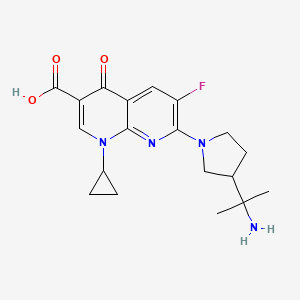
![7-[3-(1-Aminoethyl)pyrrolidin-1-yl]-1-(2,4-difluorophenyl)-6-fluoro-4-oxo-1,8-naphthyridine-3-carboxylic acid](/img/structure/B1679103.png)
![(3S)-3-[[(2R)-2-(2-adamantyloxycarbonylamino)-3-(1H-indol-3-yl)-2-methylpropanoyl]amino]-4-(4-aminophenyl)butanoic acid](/img/structure/B1679104.png)
![(3R)-3-[[(2S)-2-(2-adamantyloxycarbonylamino)-3-(1H-indol-3-yl)-2-methylpropanoyl]amino]-4-phenylbutanoic acid](/img/structure/B1679105.png)
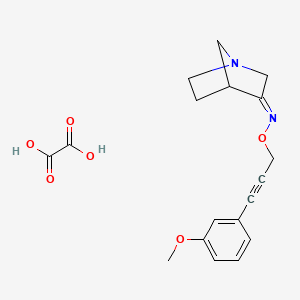
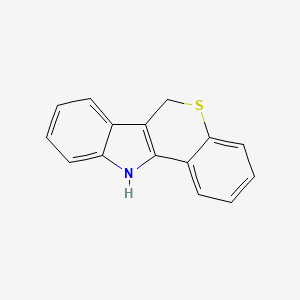
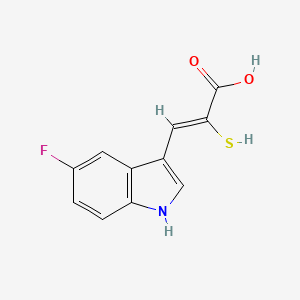
![tert-butyl N-[(2S)-1-[[(2R)-2-(8-hydroxyoctylamino)-2-methyl-3-phenylpropanoyl]amino]-1-oxo-3-phenylpropan-2-yl]carbamate](/img/structure/B1679114.png)
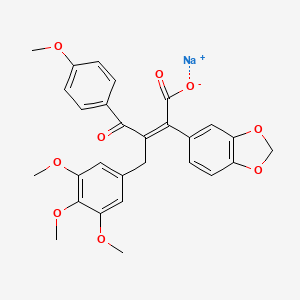
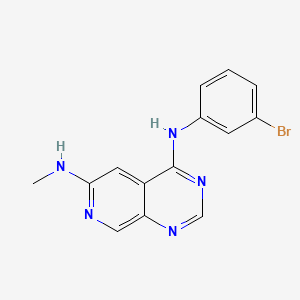

![(2S)-2-[[2,6-di(propan-2-yl)phenyl]carbamoylamino]-3-(1H-indol-3-yl)-2-methyl-N-[(1-pyridin-2-ylcyclohexyl)methyl]propanamide](/img/structure/B1679121.png)
![6-(2,6-dichlorophenyl)-2-[4-[2-(diethylamino)ethoxy]anilino]-8-methylpyrido[2,3-d]pyrimidin-7-one;dihydrochloride](/img/structure/B1679122.png)
